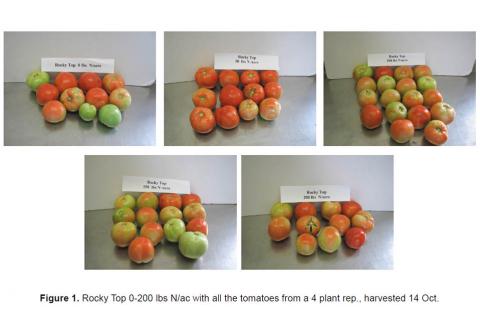
Introduction: The standard recommendation for tomatoes from the Mississippi State University Soil Testing Lab is 120lbs of actual Nitrogen per acre (N/ac). A number of Mississippi growers and extension agents have questioned if this was adequate. In the 2014 Vegetable Crop Handbook for Southeastern United States 200. 5lbs of N/ac is the recommended rate. This study was conducted to determine yield differences from the Nitrogen rates of 0, 50, 100, 150, and 200lbs N/ac applied in split applications to 3 tomato varieties, field grown in north Mississippi.
Materials and Methods: Rocky Top, Cherokee Purple, and Big Beef tomato varieties were grown in the summer/fall of 2013 and 2014 innorthern Mississippi (Table1). The experimental design was a randomized complete block with four replications. Each replication consisted of 6 plants with the middle 4 harvested for data. Raised beds were formed, 6 in high and 30 in across the top, with a press-pan-type beds haper that installs drip-tape as the bed is formed. Plants were irrigated to apply approximately 1 acre inch (27,000gal/ac) of water/week minus rainfall. Plants were spaced 2ft. apart in the row and rows were on 8ft. centers. Plants were greenhouse seeded the 1st week of July and transplanted to the raised beds the last week of July. Are bar/tomatos take was driven between every two plants for support and the Florida weave trellising technique was used. Ammonia nitrate was the nitrogen source. All plots receive done-half the assigned Nitrogen rate 7 days after transplant (DAT), 1/4 rate was applied 27 DAT, and the final 1/4 rate was applied 48 DAT. No lime or P was required but all the K, 180lbs/ac of 0-0-60, was applied pre-plant according to Mississippi State Soil Testing Laboratory recommendations. Amotorized back pack mist sprayer was used for insect and disease control. The insecticides Asana, Warrior, Insecticidal Soap, and Bt (Bacillusthuringensis), were mixed with the fungicides BravoWS, Quadris, or Kocide and sprayed every 7-10 days. Harvest began early October and every 3-5 days until the last harvest after the first killing frost in early to mid November.
Results: In 2013 total per plant yields of the 200 and 150lbs N/ac rates were significantly greater than the 50 and 0lbs N/ac but not greater than 100lbs N/ac which had the highest total number (24.3) of tomatoes (Table2). The total number of the 200 and 100 lbs N/ac rates were significantly greater than the 0 and 50lbs N/ac but not the 150lbs N/ac. The 5 nitrogen rates had no significant yield effect on the weight or number of the Jumbo grade however in the Extra Large grade 200 and 100lbs N/ac out produced 50 and 0lbs N/ac. Rocky Top yielded the most Jumbo, Big Beef yielded the most Extra Large with Cherokee Purple being intermediate (Table3). Cherokee Purple, a heirloom variety, produced many severely cracked and misshaped culls. Over 95% of the marketable yields were the jumbo and extra large grades therefore the large and medium grade data was not included here. This data shows that the recommended rate of 120lbs N/ac is more than adequate to maximize yields. In 2013 & 2014 the N treatments had no effect on cull numbers or weights, however Rocky Top had the fewest culls.
